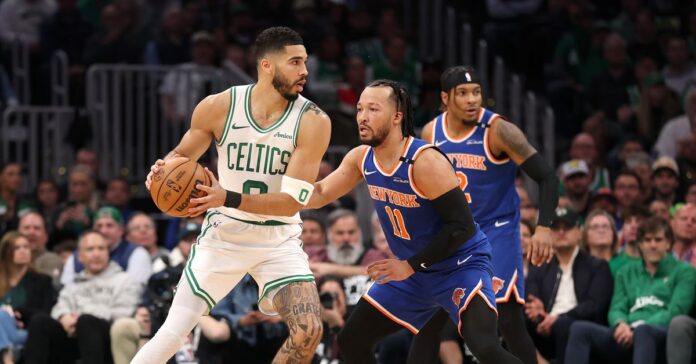With 5:41 left in the third quarter of Game One, and 3:12 left in the third quarter of Game Two, the Celtics held 20-point leads over the New York Knicks. They lost both games. That doesn’t just happen by chance.
When looking at the second-half collapses in both games, they were nearly identical. While the Knicks are a talented team that deserves plenty of respect, these collapses were more of the Celtics shooting themselves in the foot than anything else.
Let’s identity the common themes that led to these collapses.
Role players opening the floodgates
In either game, the Knicks’ role players cracked open the game when the Celtics were up big.
In Game One, it was OG Anunoby. When OG scored his first bucket of the third quarter, the C’s were up by 17. Anunoby ended up scoring 10 in the third quarter altogether, sparking the Knicks’ comeback, where they trailed by just 9 to close the quarter.
A similar story unfolded in Game Two. With 11:12 to go in the fourth quarter, Mikal Bridges hit a shot to put the Knicks within 13. An ensuing 14-point quarter from him had a similar effect for New York. Not to mention, he stole and blocked the ball to seal both games.
In playoff games, you never want to give the other team life. When you have them on the ropes, you need to knock them out. Allowing guys like OG and Bridges gave the rest of New York’s stars — namely Jalen Brunson — a new air of confidence. That is the last thing the Celtics want.
Delayed offensive action late in games
Late in both games, the Celtics have slowed things down significantly, but that’s not atypical. When things get tight in crunch time, every team tends to be more calculated, methodical, and slow. However, Boston hasn’t been calculated or methodical. They’ve just been slow.
Rather than immediately getting into diverse offensive actions to move the Knicks’ defense, the Celtics have been dribbling across the perimeter or holding the ball while the defense settles.
In this clip below, the C’s get two chances, both of which they leave Tatum on an island to figure it out himself. While the ball-handler — in this case Tatum — tries to force some sort of action, the rest of the team has been watching:
The Celtics did slightly better in Game Two of creating action and getting better shots down the stretch; however, it was still not to the level they are capable of — especially on the last possession.
These stagnant possessions lead to forced, poor shots from the perimeter that simply don’t constitute efficient offense, especially when you desperately need a bucket.
Don’t stop seal-hunting
The Knicks have two of the NBA’s worst defenders in their starting lineup. With every chance they have, the Celtics should be attacking Jalen Brunson and Karl-Anthony Towns. In fact, they can often get both of them in a pick-and-roll, picking which one they want to expose.
Every Celtic is at fault for this one, but let’s just focus on Jayson Tatum specifically.
It all started in Game One. With the game tied at 89, Tatum got KAT on a switch with a clear right-hand driving lane to the hoop — at worst, he would draw a foul. Instead, he launched a step-back three. Then, up 98–97, he got Brunson on a switch, with another clear lane. Missed step-back three. Then, with the game still at 98–97 with a minute and a half left, Tatum drew Brunson again. You guessed it — missed step-back three. Last, and certainly not least, with Mitchell Robinson on an island, the game tied with 10 seconds left, Tatum launched yet another step-back brick:
It wasn’t much different in game two. Tatum wasn’t hoisting up step-back threes, however, Boston’s ineptitude for exposing mismatches was similar. Just look here, a clever screen drew Brunson defense for Tatum, and he gives up the ball with little fight:
It’s not that they aren’t finding the seals, it’s that they aren’t attacking them. Boston needs to follow their philosophy and expose New York’s weak links with intentionality.





















